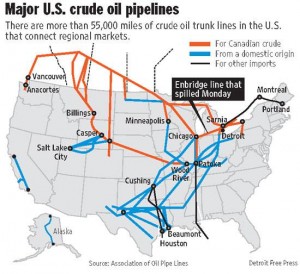In yesterday’s post, I talked about a Canadian company attempting to use northern Minnesota to generate a profit for their shareholders while avoiding responsibility for the environmental havoc they’d create while doing so. Today, we’ll discuss another Canadian company that’s trying the same thing.
Enbridge Energy’s been in the news quite a bit recently due to numerous pipeline spills and railway accidents. Enbridge’s northern US office is in the Twin Ports area (Duluth, Minnesota and Superior, Wisconsin), and employs 750 people (between employees and contractors) in the area. Superior is a hub for existing pipelines that cross northern Minnesota and pipelines that go to refineries in the Midwest and South.
Enbridge is currently proposing four projects in the area:
- The all-new $2.6 billion Sandpiper pipeline from western North Dakota to Superior, part of it along new routes from past lines, mostly to handle oil from the Bakken oil fields. The company needs state approval for the project.
- A $7 billion replacement of Enbridge’s old Line No. 3 to nearly double the capacity of oil shipped from northwestern Canada to Superior by replacing an old line with a new line. The route is yet to be determined. Since it replaces an existing pipeline, Federal approval may not be necessary, but Enbridge says it will seek approval from the state of Minnesota.
- The Alberta Clipper expansion project to increase the amount of oil flowing on the existing pipeline by 40 percent to 800,000 barrels (33.6 million gallons) of oil each day. This pipeline (also known as Line 67) runs 1000 miles from Canada to Superior, where it connects with other pipelines. The current pipeline was finished in 2010; the cost was $1.2 billion.
- Construction of oil storage tanks in Superior.
![CNRL Horizon processing plant in the Athabasca Oil Sands of Alberta, Canada. Burn from the 2011 Richardson Fire visible in foreground. Photo by The Interior (Own work) [CC-BY-SA-3.0 (http://creativecommons.org/licenses/by-sa/3.0) or GFDL (http://www.gnu.org/copyleft/fdl.html)], via Wikimedia Commons](http://occupyworldwrites.org/wp-content/uploads/2014/03/1024px-Horizonplantandburn-225x300.jpg)
CNRL Horizon processing plant in the Athabasca Oil Sands of Alberta, Canada. Burn from the 2011 Richardson Fire visible in foreground. Photo by The Interior (Own work) [CC-BY-SA-3.0 (http://creativecommons.org/licenses/by-sa/3.0) or GFDL (http://www.gnu.org/copyleft/fdl.html)], via Wikimedia Commons
In the first two years of the first phase of TransCanada’s Keystone XL project, there were 14 leaks. And, from 1999-2010, Enbridge had 804 spills along its pipeline network. This isn’t the kind of record that instills confidence in the companies involved, especially when you’re dealing with the pipeline running over aquifers in the case of Keystone, and through national forest and public lands in the case of the Enbridge projects.
The mayors of Duluth and Superior support the Enbridge project. Mayor Don Ness of Duluth said “In my mind, pipelines are the most responsible and safest way to transport oil. We are seeing the problems associated with moving crude by truck and rail — transporting by pipeline reduces the energy consumption and risk of accident to transport. Our decision is not whether crude will come from Canada or North Dakota, the question is whether it’s coming on rail or pipeline. In my mind, pipeline transport is the much better option.”
When it was pointed out to him that he was the author of a 2001 resolution calling for the reduction of greenhouse gas emissions and how the pipeline would significantly increase those emissions as well as be hazardous to the environment through spillage, he replied “The pipeline makes no impact on the carbon consumption in the city of Duluth, I understand the leap of logic, but there’s not a real connection there.”
Why the apparent disconnect between his stance in 2001 and his stance today? Maybe it’s because the Enbridge projects are estimated to cost over $10 billion, with a fair amount of this being spent in the Twin Ports area. However, one has to ask if the economic boom will be worth the cost to the environment. The pipelines will leak if Enbridge’s record is the standard, and the long term effects on the environment of extracting, transporting and using the high carbon tar sands oil are very likely to be devastating on a global scale.
There’s still time to make our concerns known, though. The Minnesota Public Utilities Commission hosts a final meeting April 3 in St. Paul. The public comment period for the proposed pipeline expansion closes on April 14.
For more information about tar sands in general, we invite you to read TransCanada: Go Pound Tar Sand.


